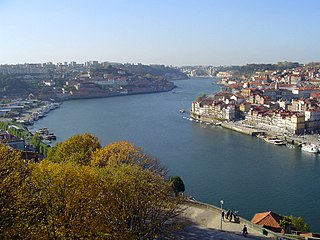
The Douro is one of the major rivers of the Iberian Peninsula, flowing from its source near Duruelo de la Sierra in Soria Province across northern-central Spain and Portugal to its outlet at Porto.

Port wine is a Portuguese fortified wine produced with distilled grape spirits exclusively in the Douro Valley in the northern provinces of Portugal. It is typically a sweet, red wine, often served as a dessert wine, though it also comes in dry, semi-dry, and white varieties. Fortified wines in the style of port are also produced outside Portugal, including in Australia, France, South Africa, Canada, India, Argentina, Spain, and the United States. Under European Union Protected Designation of Origin guidelines, only the product from Portugal may be labelled as port or Porto. In the United States, wines labelled "port" may come from anywhere in the world, while the names "Oporto", "Porto", and "Vinho do Porto" have been recognized as foreign, non-generic names for port wines originating in Portugal.

Praia da Vitória, translated as the Beach of the Victory, is a municipality in the Portuguese archipelago of the Azores. With a population of 21,035, the second largest administrative authority on the island of Terceira, it covers an area of 161.27 square kilometres (62.27 sq mi), that extends from the northern coast halfway into the interior.

Albariño or Alvarinho is a variety of white wine grape grown in Galicia, Monção and Melgaço, where it is used to make varietal white wines. Albariño is the Galician name for the grape; in Portugal it is known as Alvarinho, and sometimes as Cainho Branco.

Altares is a freguesia in the municipality of Angra do Heroísmo on the Portuguese island of Terceira in the archipelago of the Azores. The population in 2011 was 901, in an area of 28.22 km².

Serreta is a civil parish in the municipality of Angra do Heroísmo on the island of Terceira in the Portuguese archipelago of the Azores. Its elevation is approximately 471 metres (1,545 ft). The population in 2011 was 335, in an area of 14.36 km2. It is the smallest parish in the municipality by population.

Biscoitos is a civil parish in the municipality of Praia da Vitória, on the island of Terceira in the Portuguese Azores. The population in 2011 was 1,424, in an area of 27.05 km². The village has a wine museum called the Museu do Vinho dos Biscoitos that was established in 1990.

Douro is a Portuguese wine region centered on the Douro River in the Trás-os-Montes e Alto Douro region. It is sometimes referred to as the Alto Douro, as it is located some distance upstream from Porto, sheltered by mountain ranges from coastal influence. The region has Portugal's highest wine classification as a Denominação de Origem Controlada (DOC). While the region is associated primarily with Port wine production, the Douro produces just as much table wine as it does fortified wine. The non-fortified wines are typically referred to as "Douro wines".
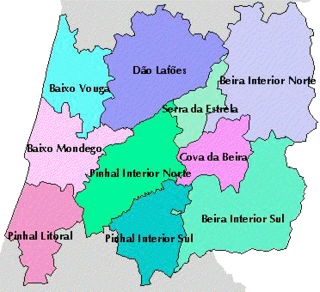
Dão is a Portuguese wine region situated in the Região Demarcada do Dão with the Dão-Lafões sub region of the Centro, Portugal. It is one of the oldest established wine regions in Portugal. Dão wine is produced in a mountainous region with a temperate climate, in the area of the Rio Mondego and Dão rivers in the north central region of Portugal. The region became a Denominação de Origem Controlada (DOC) appellation in 1990. The Dão region is the origin of the Touriga Nacional vine that is the principal component of Port wine.

Bento Gonçalves is a municipality located in the state of Rio Grande do Sul, Brazil. Created in 1875, it is one of the centers of the Italian immigration in Brazil. It is also known as the 'wine capital of Brazil' due to its vineyards and wine production. In 2016, its estimated population was 114,203 inhabitants.
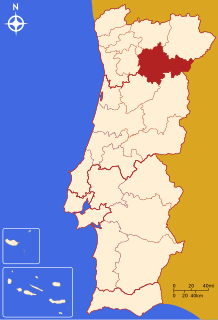
The Comunidade Intermunicipal do Douro is an administrative division in Portugal. It replaced the Comunidade Urbana do Douro, created in 2004. It takes its name from the Douro River. The seat of the intermunicipal community is Vila Real. Douro comprises parts of the former districts of Bragança, Guarda, Vila Real and Viseu. The population in 2011 was 205,157, in an area of 4,031.58 km².
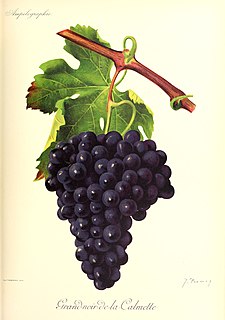
Grand Noir de la Calmette is a red teinturier grape variety that is a crossing of Petit Bouschet and Aramon noir created in 1855 by French grape breeder Henri Bouschet at his vineyard in Mauguio in the Hérault department. The grape was named after the breeding station Domaine de la Calmette. As a teinturier, Grand noir is often used to add color to wines that it is blended into but is paler than other choices such as Alicante Bouschet. The vine tends to bud late and has a high productivity but with some susceptibility to the viticultural hazard of powdery mildew.

The Açores VR is a Portuguese wine region located in the archipelago of the Azores. This region is classified as a Vinho Regional (VR), which corresponds to table wines with a geographical indication under European Union wine regulations, similar to a French vin de pays region.

Caíño tinto is a red Galician wine grape variety that is also grown in Portugal's Vinho Verde wine region where it is known as Borraçal. In Spain, it is a permitted variety in the Denominación de Origens (DOs) of Rías Baixas and Ribeiro where it produces highly perfumed wines with noticeable tartness and high acidity.
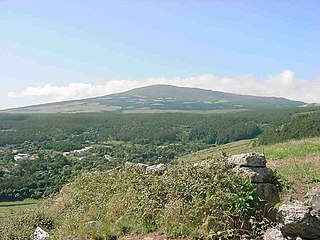
The Nature Park of Terceira (Portuguese: Parque Natural de Terceira, or simply the Terceira Nature Park developed from the intention of better managing the protected areas of the island of Terceira, and was instituted by the Secretaria Regional do Ambiente e do Mar, of the Autonomous Regional Government of the Azores. It includes an area of approximately 22% of the island classified under the International Union for Conservation of Nature's Nature Reserve designation.

Biscoito de polvilho is a Brazilian snack food, typical from Minas Gerais and Central-West region cuisines. Its basic ingredients are water, milk, oil, and cassava starch.


















